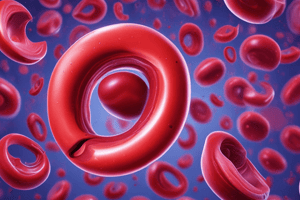Podcast
Questions and Answers
Match the following types of mutations with their descriptions:
Match the following types of mutations with their descriptions:
Frameshift mutation = Refers to the shift of the reading frame of the entire DNA chain after mutation Deletion mutation = Loss of a single base either spontaneously or due to damage Insertion mutation = Acridine intercalates between adjacent DNA nitrogen bases causing the addition of extra bases into the new mRNA Point mutation = Involves changing a single nucleotide base in the DNA sequence
Match the following consequences of DNA damage with their outcomes:
Match the following consequences of DNA damage with their outcomes:
Genomic instability = Leads to changes in the cell genome and potential development of cancer Cancer development = Result of changes to DNA structure causing genomic instability Mutation aftermath = Permanent copy of necessary cell structure encoded by DNA DNA repair mechanisms = Sets of mechanisms that identify and correct damage in DNA molecules
Match the following factors with their impact on DNA damage:
Match the following factors with their impact on DNA damage:
Incorrect nucleotide bases incorporation = Causes damage during DNA replication Spontaneous mutation = Chemical changes leading to DNA damage Radiation exposure = Environmental factor causing chemical changes in DNA Frameshift mutations = Likely to occur when any number of bases are added or deleted, except for multiples of three
Match the type of mutation with its definition:
Match the type of mutation with its definition:
Match the type of point mutation with its specific example:
Match the type of point mutation with its specific example:
Match the clinical significance with the specific mutation example:
Match the clinical significance with the specific mutation example:
Match the environmental factor with its impact on mutations:
Match the environmental factor with its impact on mutations:
Match the DNA repair mechanism with its description:
Match the DNA repair mechanism with its description:
Match the enzyme with its role in DNA repair:
Match the enzyme with its role in DNA repair:
Match the type of damage with its corresponding DNA repair mechanism:
Match the type of damage with its corresponding DNA repair mechanism:
Match the term related to DNA repair with its definition:
Match the term related to DNA repair with its definition:




